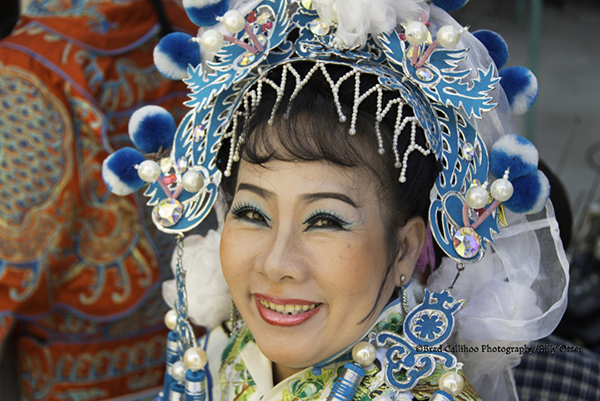By: Jody Hanson
Billy Otter – photographer extraordinaire – peered through a window and spotted some women being painted – literally – for a Vietnamese opera performance. Heavy make-up, white powered faces, starched hair.

Courtesy of Brad Callihoo Photography / Billy Otter
Without a moment of hesitation he marched in and started shooting photos. Within a few minutes the performers posed, smiled and followed his sign-language instructions for the photographs he wanted to take.
As an aside, Billy lost a leg in a motorcycle accident in Canada. Since he wears shorts, his artificial leg serves him well in South East Asia. People in this part of the world know that he, too, has suffered. It creates an almost automatic empathetic connection that gets him into places that other barang (foreigners) wouldn’t be allowed.
Meanwhile, I’m standing out on the sidewalk on a side street in Ho Chi Minh watching the performance of him doing the photo shoot.
As Billy emerged from the dressing room, an older man came over and indicated we should follow him down a narrow weaving alley. We look at each other, shrugged our shoulders and fell into step behind him.
The drama of it all
Even before we got to the performance area I recognized the gonging, clanging and yelping of the Chinese-style opera.
Ushered into the space, Billy continued to work with his camera. I was given a plastic chair and a paper fan to ward off the flies and generate a bit of breeze. Nobody spoke any English so we never did figure out what the celebration was about. Wedding? Birthday? Funeral? It remained a mystery.
People ate, visited and wandered around while the opera provided background entertainment. Some watched it intensely; others didn’t notice it at all.
Introduction to opera
I taught at a university in southwest China from 1986 to 87, so the opera was simply a step back in time. At first we foreigners were ushered to events we were expected to attend as part of our Middle Kingdom cultural experience. Later I started going to the performances on my own. That was when I questioned if I had been in the country too long, because I actually started to enjoy the genre.
The language matters little with traditional Chinese/Vietnamese opera. The characters are stock standard and clearly fall into good or bad. Exaggerated. No middle ground there. Knowing the plot isn’t important, as not much happens anyway.
The “modern” performances – produced after 1949 – were predictable. Remember in 1986 to 87 the People’s Republic was still a closed country and the mass majority of people were still in blue Mao suits. The operas always had the people being freed from the capitalist oppressors by the glorious Red Army.
Tension is indicated with the clanging and the gonging. Women do most of the verbal work. It can’t really be called “singing” as it is more like shrieking three and a half octaves above middle C at dangerous decibel levels. Think of stepping on a cat’s tail with a spiked heel and that about describes it.
History of Vietnamese Opera
Hat Tuong – as Vietnamese opera is now known – was imported from China around the 13th century. Once established in Vietnam, the locals added their own twists and turns.
I would be hard pressed to identify the differences of the two cultural versions, but I was quick to notice the similarities.
Alas, like many traditional arts the world over, Vietnamese opera is on the decline. English speaking locals we met later confirmed it is difficult for opera performers to make a living, so they generally have to take on other jobs to support their lifestyles.
Rather like the west: if it weren’t for struggling artists, singers, and actors; coffee shops would be hard-pressed to find staff.
There are some people in Vietnam who are trying to revive the art form and keep it viable.
So a visit to Vietnam should definitely involve attending an opera, as it is best seen as a live performance. Even if you don’t bond with the genre, it is still an experience.
In case you are busy travelling in South America or Africa, here are some videos that will give you an inkling about it!
About the Author
Jody Hanson is an insufferable travel junkie who has visit 107 countries – 67 on her own – lived in nine and holds passports in three. She has visited all the countries in North, Central and South America except for Venezuela, Guyana, Surname and French Guinea. She wrote this article on behalf of Tucan Travel who offer all types of travel excursions to Vietnam and throughout Southeast Asia.
Featured image via Unsplash.

